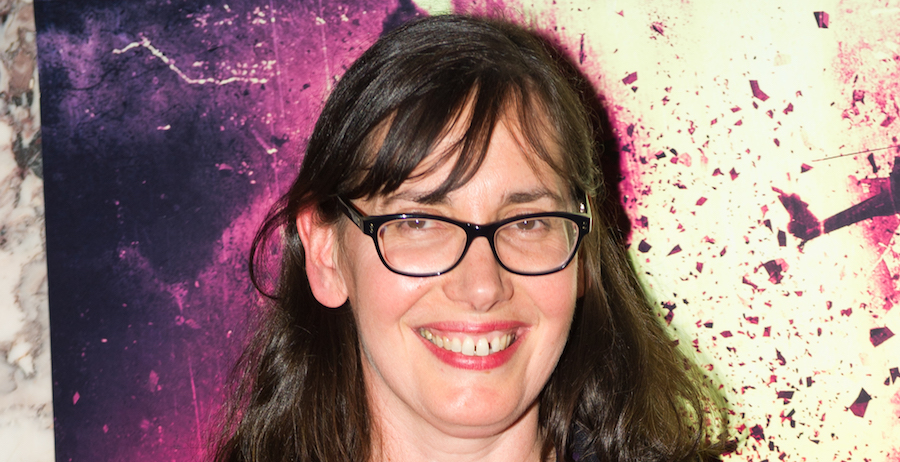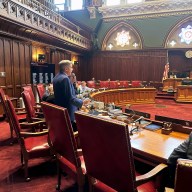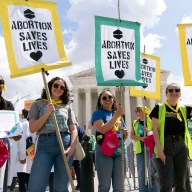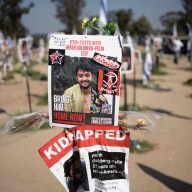Eleven years ago, French filmmaker Lucile Hadzihalilovic shocked the film festival circuit with “Innocence.” At once familiar, even easy to understand, and yet mysterious and enigmatic, it was set at a strange school, buried deep in the woods, where young girls were taught what was really important: how to look pretty, how to dance, how to know their place in society. They were, in short, being educated in how to conform to restrictive gender norms. But it was filled with such bizarre imagery, told with such a strong sense of mood, that it still managed to perplex, even if its meaning was clear as day. Hadzihalilovic finally returns with “Evolution,” which sounds similar. We drop into another remote microcosm: a seaside village, populated exclusively by young boys, each lorded over by a mom whose ties might not be biological. When one of them, Nicolas (Max Brebant) starts misbehaving, he’s sent to a grimy hospital, which is when things get really weird. But it’s not “‘Innocence’ for boys.” Just as slow and even more menacing, it’s harder to crack — not that figuring it out is vital to enjoying it. Hadzihalilovic — who has also collaborated with Gaspar Noe on his films “Carne,” “I Stand Alone” and “Enter the Void” — talks to us about not explaining everything, working with children and how she hopes midnight movie audiences will accept a movie like this. RELATED: Review: “Evolution” is a French head trip that dares you to figure it out I don’t want you to explain what everything in “Evolution” means, but I imagine you get asked to do just that a lot. It’s a strange habit humans have, to want everything to be understandable. When you’re coming up with some of the images or ideas, do you tend to just do it instinctually and not question what everything you imagine means? How do you work with the people who design, say, some of the strange creatures in “Evolution”? How specific are you about what you want? You came up with the idea for this before “Innocence.” How did the idea grow over the years — or, well, evolve? (Sorry.) What motivated you to make a film about young boys? Making the lead a girl might have made it more loaded, inspired viewers to read it as feminist, when it’s not really dealing with those ideas. How do you work with child actors? How much do you explain to them? This is a tough movie to classify. It’s an art film, but it’s being sold in America as a midnight movie. Do you worry about with genre people say it is?
I think most people are talking superficially about the narrative. But I do think both films are somehow quite direct, even simple. The themes or the emotions or situations aren’t so complicated and not so weird. But I still like things to be ambiguous and ambivalent and kind of unstable. I guess some audiences want to be sure they’re right, or think that the director knows better than them — when in fact I think the films belong to the audience.
At the beginning it’s very instinctive and all about images and sometimes details and mood. Sometimes it’s about character. But then I get to a process of writing the script and organizing these ideas. This wasn’t the case with “Innocence,” which was based on an existing story. But for “Evolution” I worked with a cowriter [Alante Kavaite]. We talked a lot about the meaning of things and how to verbalize everything. So it’s both instinctive and then going through a process of being more conscious of what I’m doing and what I’d like to share.
It’s important to find the right person with the same kind of sensibility, who can understand where I want to go. For instance, with “Evolution,” when I was working with the guy who was making the creatures, the babies, we had to discuss whether it’s supposed to be a monster or if it’s supposed to be human. I need the people I’m working with to help me make things more visual. What is unconscious becomes more conscious. The choices we make make it more rich, but they also make the film more precise.
Before “Innocence” it was more about the hospital part. It was really more this idea of the boy at the hospital with something in his belly, and the mother was there. But it was more of a realistic environment. Then I thought, ‘What is outside the hospital?’ At some point I realized it should be by the sea. Then I stopped working on that project and worked on “Innocence.” Afterwards I started to organize this little microcosm, which is a bit like the community in “Innocence.” But for me it was a much more intimate story, more psychological than “Innocence,” which was more about a society and how you raise girls.
It was more an idea of making a film about a child who would have this fear of being manipulated by adults, and having something very strange coming into his body — this idea of becoming a teenager and having your body touched. Then I thought it was more interesting to make it a boy. Because it was less obvious and more nightmarish. Also because it doesn’t deal with sexuality. There is a kind of pre-sexuality in the film. I thought it was more about a child than specially a boy or a girl.
It would be more obvious — the girl who is a victim. I wanted it to have these abnormal and scary elements. It could have been with a girl, but I wanted it to be some kind of fantasy and link it to a more realistic environment. With a girl, that might not have been the case.
It was never a problem. With “Evolution,” the boy who played Nicolas was 13 years old; he was not that young. He was able to read the script — or I think he read it. [Laughs] At least he told me he did. He really didn’t care about the story. His only questions were about the injections. He was afraid they would be for real. Otherwise it was the same as with “Innocence.” They didn’t care about the story; they cared about the experience of making the film. For “Evolution,” what was exciting for them was going to an island, having to swim, pretending to be sick and pretending to be dead. The more strange it was for them, the more fun it was. It was a game. They weren’t worried about the scary aspects of the story; they were just happy to be chosen. [Laughs]
I don’t understand this separation between art house film and genre film. When I was trying to make the film, I had a lot of problems with that, because I don’t understand why a film that has elements of horror or sci-fi could not be an art house film. It was quite obvious to me that this wasn’t the kind of film that existed just for entertainment, with some shocking images and surprises that can be fun for teenagers. I was very surprised there was always this distinction. Even now that the film is finished, distributors feel the need to put it in some kind of box. We’ll see. I hope the audience for midnight films are open to a slow-paced film with no explanations. [Laughs]
Lucile Hadzihalilovic doesn’t want to classify her film ‘Evolution’

Getty Images
Follow Matt Prigge on Twitter @mattprigge


















